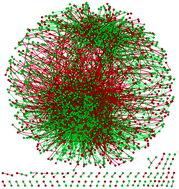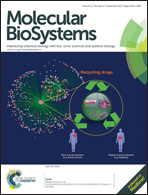Identification of module biomarkers from the dysregulated ceRNA–ceRNA interaction network in lung adenocarcinoma†
Abstract
Competitive endogenous RNA (ceRNA) represents a novel layer of gene regulation that plays important roles in the physiology and development of diseases such as cancer and its dysregulation could contribute to cancer pathogenesis. Here, we have proposed a computational method to systematically identify genome-wide dysregulated ceRNA–ceRNA interactions by integrating microRNA regulation with expression profiles in cancer and normal tissues by RNA sequencing, as well as considering the details of how the behavior of ceRNAs has changed. These gain or loss dysregulations further assemble into a dysregulated ceRNA–ceRNA network; lncRNAs and pseudogenes are also considered. After applying the method to lung adenocarcinoma, we found that most dysregulations are connected together and formed a lung adenocarcinoma dysregulated ceRNA–ceRNA network (LDCCNet). Our analyses found that ceRNA pairs with gain regulations have consistent expression in cancer, otherwise for loss regulation, it is not necessary. Moreover, ceRNAs with more significant gain regulations (gain ceRNAs) undergo stronger regulation in cancer; thus their expression is more likely to decrease in cancer, while the expression of loss ceRNAs displays a rising trend. Additionally, we found that gain and loss ceRNAs as topological key nodes are implicated in the development of cancer. Finally, dysregulated ceRNA modules were identified, which are significantly enriched with known lung cancer microRNAs. We further found that several modules have the power as diagnostic biomarkers even in three independent datasets. For example, the module with lncRNA RP11-457M11.2 as a center is involved in the epithelial cell morphogenesis process and provides the average AUC values of 0.95. Our study about LDCCNet opens up the possibility of a new biological mechanism in cancer that could serve as a biomarker for diagnosis.


 Please wait while we load your content...
Please wait while we load your content...